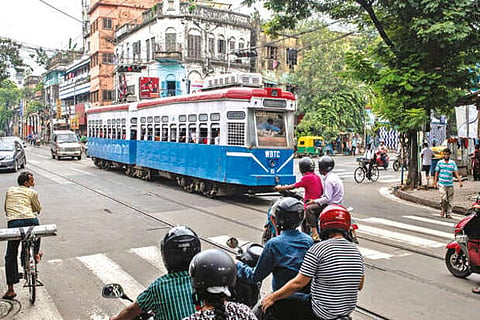

New York
The tram rattled along College Street, passing dozens of bookstalls, and announcing itself with the quaint chime of a bell.
A gentle breeze from its open windows and antique ceiling fans cut the humid summer heat.
Sounds and smells from the streets wafted in — fresh fish splayed out on the sidewalk, the muezzins’ call to prayer — as the tram passed vegetable wagons and ornate colonial buildings.
In recent years, hit by natural disasters and official neglect, the city’s tram system has become little more than a nostalgia ride, its passengers more often looking for a lark than an efficient trip home. And the authorities say that while trams should remain a part of the transit mix, buses, and the city’s metro system better serve 21st-century riders in the city of some 15 million people.
The tram system, built-in 1881, was instrumental in Kolkata’s growth into one of the world’s most populous cities, cutting the path for the development of a metropolis on the move.
“We grew up as a city with the tramways,” said Aranda Das Gupta, some of whose earliest memories are of the tram rolling past his great-grandfather’s bookstore, which opened just five years after the tram first arrived. “It’s the heritage of Kolkata.”
A few committed riders are fighting hard to preserve that heritage. Pointing to cities from San Diego to Hong Kong, they say light rail is being re-evaluated globally, and argue that Kolkata’s 140-year-old system makes sense for a city struggling with pollution and overcrowding.
In an age of growing concerns about climate change, the emission-free trams, powered by overhead electric lines, are a better option than diesel-fuelled buses and private cars, activists say.
The trams were briefly pulled by horses, an experiment that ended in less than a year after too many horses succumbed to the heat. “Scientifically, economically, environmentally, there is no reason to convert the tramways for buses,” said Debasish Bhattacharyya, president of the Calcutta Tram Users’ Association.
But the scene at one tram stop suggested commuters may feel differently. Fewer than half a dozen people were waiting for the tram, while nearby, hundreds were piling onto buses that sagged under the weight of so many passengers.
Admittedly, neither speed nor punctuality is the hallmark of the trams, which must contend with a mélange of traffic on their routes: trucks, buses, cars, vintage yellow Ambassador taxis, rickshaws manual, and electric, pedestrians, herds of goats, and the occasional cow.
Six tram routes remain operational in a system that used to resemble a bicycle wheel. Now, most of the spokes have been broken off, leaving vast swaths of the city uncovered by tram lines.
But to preservationists, what’s left of the trams — as much a Kolkata institution as the universities the steel carriages trundle past, or the city’s cantilever bridge — must be saved. “If they announce the discontinuation of tram service, there will be public unrest,” Bhattacharyya predicted.
So instead of any sudden shutdown of service, he argued that the authorities are allowing the system to disappear quietly, by failing to make critical repairs.
Many of Kolkata’s urban landmarks — from cinemas and bookstores to museums and hospitals — were built near the tracks. One of those institutions was Das Gupta Books, founded in 1886.
Aranda Das Gupta, the shop’s fourth-generation managing director, called the tram a “beautiful journey,” while acknowledging that it takes “maximum time.” “Nowadays,” he said, “people want to move fast.”
Emily Schmall is a reporter with NYT©2021
The New York Times
Visit news.dtnext.in to explore our interactive epaper!
Download the DT Next app for more exciting features!
Click here for iOS
Click here for Android